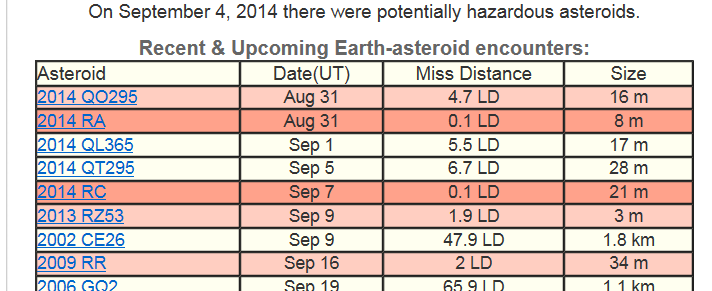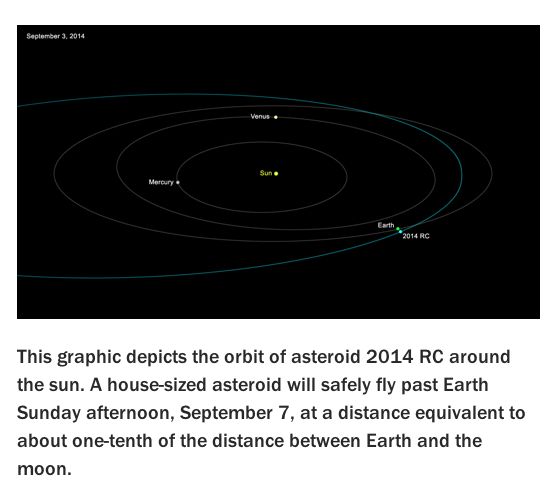It looks like you're using an Ad Blocker.
Please white-list or disable AboveTopSecret.com in your ad-blocking tool.
Thank you.
Some features of ATS will be disabled while you continue to use an ad-blocker.
15
share:
I've never seen two such near misses in such close proximity to each other, has anyone else?

Space weather page
Scroll down for the chart.
I know this is way out there, but is the reason behind these why we seem to have so many distractions going on in the media right now, all of which could be orchestrated? Gaza, Ukraine, ISIS (or whatever they are called now), NATO, nude pics.....divert us from the real issue?

Space weather page
Scroll down for the chart.
I know this is way out there, but is the reason behind these why we seem to have so many distractions going on in the media right now, all of which could be orchestrated? Gaza, Ukraine, ISIS (or whatever they are called now), NATO, nude pics.....divert us from the real issue?
originally posted by: OccamsRazor04
a reply to: PlanetXisHERE
What real issue? That objects came close and had no chance to hit us?
You haven't looked at the date.
It still hasn't arrived. (or passed). It's three days away. Not a end of life event if it were to impact, but would still FUBAR a city if it were to hit one.
a reply to: swanne
I did a sim on this site assuming the heaviest density at a 45 degree angle.
www.purdue.edu...
If it did impact, it would have a 10MT energy release and have no significant damage to the earth...except for those nearby of course.
If it plopped into a ocean somewhere with no islands around, we wouldn't even feel it, though I'm sure that it would provide some great YT videos upon entry. And it would be a BIG plop as well.
I did a sim on this site assuming the heaviest density at a 45 degree angle.
www.purdue.edu...
If it did impact, it would have a 10MT energy release and have no significant damage to the earth...except for those nearby of course.
If it plopped into a ocean somewhere with no islands around, we wouldn't even feel it, though I'm sure that it would provide some great YT videos upon entry. And it would be a BIG plop as well.
The following is my opinion as a member participating in this discussion.
The August 31st one went by at the same distance without a problem. I'm sure this one will too. Now if it said .01 LD ... then I'd be wondering about it ...
As an ATS Staff Member, I will not moderate in threads such as this where I have participated as a member.
a reply to: FlyersFan
I know next to nothing about asteroids so I had to ask ATS: Even though one passed at .1 LD on August 31, it was 8 meters. Since this is 21 meters, is there a chance that because it's a bit heavier the Earth's gravity could pull it in?
Just speculating. Thanks
I know next to nothing about asteroids so I had to ask ATS: Even though one passed at .1 LD on August 31, it was 8 meters. Since this is 21 meters, is there a chance that because it's a bit heavier the Earth's gravity could pull it in?
Just speculating. Thanks
a reply to: FlyersFan
Ya, I guess 1/10th LD is about 38,400 km, which is a little over 3x the diameter of earth, definitely some room for error. I think I'd be a little more worried once any were (projected) within one earth diameter, about 0.032 LD.
I wonder what the closest any asteroid of any significant size has come without hitting? At what LD would an object be captured by the earth's gravity? I guess that would depend on the mass and speed of the asteroid.
Ya, I guess 1/10th LD is about 38,400 km, which is a little over 3x the diameter of earth, definitely some room for error. I think I'd be a little more worried once any were (projected) within one earth diameter, about 0.032 LD.
I wonder what the closest any asteroid of any significant size has come without hitting? At what LD would an object be captured by the earth's gravity? I guess that would depend on the mass and speed of the asteroid.
a reply to: Yeahkeepwatchingme
Oh jeez, looks like you were writing the same question at the same time as me! Just off the top of my head, I'm guessing three earth diameters out would be too far, I would hazard a guess it would have to be at least less than one earth diameter, which as I said above is approx. 0.032 LD's.
Oh jeez, looks like you were writing the same question at the same time as me! Just off the top of my head, I'm guessing three earth diameters out would be too far, I would hazard a guess it would have to be at least less than one earth diameter, which as I said above is approx. 0.032 LD's.
Any impact in the sea would cause a huge tsunami. This could cause problems for nuke power stations situated by the sea as many of them are for their
cooling needs.
We only have to remember Fukushima and what happened there and then realise that a tsunami like this may well overrun one or more power stations on the coast of any country nearby.
We only have to remember Fukushima and what happened there and then realise that a tsunami like this may well overrun one or more power stations on the coast of any country nearby.
With the tools of even 15 years ago, we probably would not have known that any of these grazers were in the neighborhood.
The rate of observance goes up with the technology, so it is a difficult theory to say that the number of asteroids that we would normally come across, are increasing. The average for something like Chelyabinsk coming around is close to a century, so we (theoretically) , should not expect something like that, or larger, for a while. (I hope.)
The rate of observance goes up with the technology, so it is a difficult theory to say that the number of asteroids that we would normally come across, are increasing. The average for something like Chelyabinsk coming around is close to a century, so we (theoretically) , should not expect something like that, or larger, for a while. (I hope.)
originally posted by: charlyv
With the tools of even 15 years ago, we probably would not have known that any of these grazers were in the neighborhood.
The rate of observance goes up with the technology, so it is a difficult theory to say that the number of asteroids that we would normally come across, are increasing. The average for something like Chelyabinsk coming around is close to a century, so we (theoretically) , should not expect something like that, or larger, for a while. (I hope.)
Sure, technology has improved, and I'm sure our ability to see further out in the solar system has improved, but even two decades ago we would have noticed these asteroids at their closest approach to earth, and I'm sure we were recording all that came within a few LD's of earth.
originally posted by: TDawgRex
originally posted by: OccamsRazor04
a reply to: PlanetXisHERE
What real issue? That objects came close and had no chance to hit us?
You haven't looked at the date.
It still hasn't arrived. (or passed). It's three days away. Not a end of life event if it were to impact, but would still FUBAR a city if it were to hit one.
You are right, I didn't, there is no need to bother. It's not like the trajectory can't be determined, and it's not a big deal.
new topics
-
What is the white pill?
Philosophy and Metaphysics: 51 minutes ago -
Mike Pinder The Moody Blues R.I.P.
Music: 1 hours ago -
Putin, Russia and the Great Architects of the Universe
ATS Skunk Works: 4 hours ago -
A Warning to America: 25 Ways the US is Being Destroyed
New World Order: 9 hours ago
top topics
-
President BIDEN's FBI Raided Donald Trump's Florida Home for OBAMA-NORTH KOREA Documents.
Political Conspiracies: 14 hours ago, 33 flags -
A Warning to America: 25 Ways the US is Being Destroyed
New World Order: 9 hours ago, 17 flags -
Is AI Better Than the Hollywood Elite?
Movies: 16 hours ago, 4 flags -
Mike Pinder The Moody Blues R.I.P.
Music: 1 hours ago, 4 flags -
What is the white pill?
Philosophy and Metaphysics: 51 minutes ago, 3 flags -
Putin, Russia and the Great Architects of the Universe
ATS Skunk Works: 4 hours ago, 2 flags -
Maestro Benedetto
Literature: 16 hours ago, 1 flags
active topics
-
Mood Music Part VI
Music • 3109 • : TheWoker -
Candidate TRUMP Now Has Crazy Judge JUAN MERCHAN After Him - The Stormy Daniels Hush-Money Case.
Political Conspiracies • 791 • : matafuchs -
Meadows, Giuliani Among 11 Indicted in Arizona in Latest 2020 Election Subversion Case
Mainstream News • 22 • : xuenchen -
President BIDEN's FBI Raided Donald Trump's Florida Home for OBAMA-NORTH KOREA Documents.
Political Conspiracies • 28 • : TzarChasm -
Gaza Terrorists Attack US Humanitarian Pier During Construction
Middle East Issues • 64 • : DBCowboy -
So this is what Hamas considers 'freedom fighting' ...
War On Terrorism • 263 • : ToneD -
What is the white pill?
Philosophy and Metaphysics • 1 • : Astyanax -
A Warning to America: 25 Ways the US is Being Destroyed
New World Order • 21 • : MetalThunder -
Truth Social goes public, be careful not to lose your money
Mainstream News • 133 • : Astyanax -
New whistleblower Jason Sands speaks on Twitter Spaces last night.
Aliens and UFOs • 70 • : baablacksheep1
15

